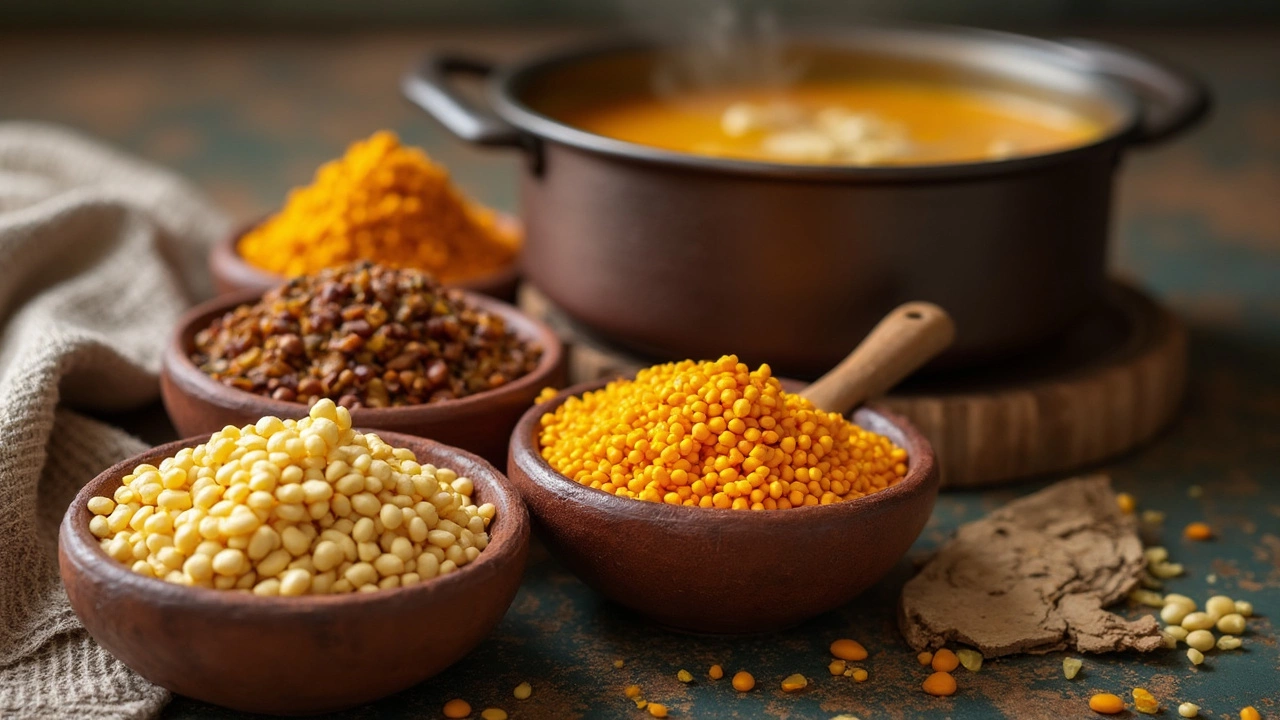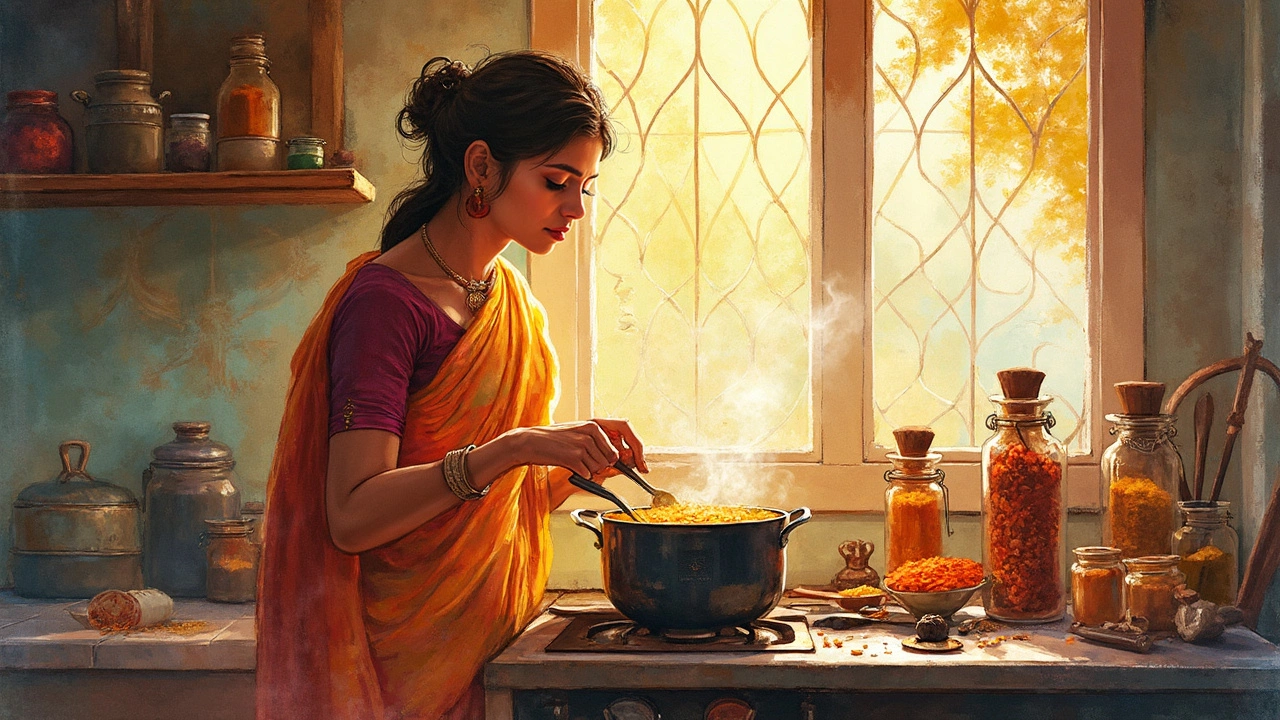No pressure cooker? No problem. Cooking dal on a stovetop works just fine, and honestly, people have been doing it this way for ages—grandmas everywhere have proved it. All you really need is a regular pot and a little extra patience. Lentils don’t judge your kitchen setup.
If you’re worried it’ll take forever, here’s a little secret: soaking your dal before cooking cuts the time almost in half. Swirling them in water while you prep your other ingredients helps remove that starchy, cloudy stuff and makes the dal cook evenly. Plus, you get a creamier finish.
Some types of dal like masoor (red lentils) or moong (split yellow dal) cook super fast even without a cooker—sometimes under 30 minutes. Tougher ones like chana dal or whole urad do take longer but still aren’t impossible. Just give them a longer soak and a bigger pot of boiling water.
The best part? You get to keep an eye on the texture as it cooks. If you like your dal thick or soupy, you can control it. No more mushy surprises or burnt bottoms because the cooker lid was sealed too tight.
- Cooking Dal Without a Cooker: What You Need
- Step-by-Step: Stovetop Dal Made Simple
- Tips to Speed Up the Process
- Common Mistakes and How to Avoid Them
Cooking Dal Without a Cooker: What You Need
If you’re skipping the pressure cooker, don’t stress. Most of what you need is already in your kitchen. The trick is to keep things simple and use what works.
- Dal (Lentils): Pick any variety you like. Masoor (red), moong (yellow split), toor (pigeon pea), and chana dal (split Bengal gram) are all popular. Just remember, whole dals like chana or urad take longer to cook.
- Heavy-bottomed pot or saucepan: This helps stop your dal from sticking or burning while it simmers. Aluminum or steel works, but nonstick is fine, too.
- Water: You’ll need a bit more than usual since steam can escape from an open pot. As a rule, use about 3 cups of water for every cup of dal.
- Salt: Don’t forget this—it actually helps dal cook faster as it starts to soften the lentils.
- Optional: Turmeric, ginger, or a bay leaf. These little extras add flavor and help your gut.
- Spoon or ladle: For stirring now and again, so nothing gets stuck at the bottom.
Want it to cook faster? Soak your dal for at least 30 minutes if you have time. You’ll thank yourself later when you see how much it speeds things up.
| Type of Dal | Time Needed (minutes) |
|---|---|
| Masoor (red lentils) | 20–25 |
| Moong (yellow split) | 25–30 |
| Toor (pigeon pea) | 35–50 |
| Chana dal | 45–60 |
| Whole urad | 60–75 |
Pay attention to the dal without cooker method if you don’t want to fuss with gadgets. You’re in control—just adjust water as needed, stir every now and then, and taste as you go. There’s no right or wrong. It’s all about what works for you right now.
Step-by-Step: Stovetop Dal Made Simple
Here’s how to make dal the easy, old-school way—no pressure cooker, no hassle. Just straight-up, fuss-free comfort food in your kitchen. For most dals, you’ll want a 1:3 ratio of dal to water if you like it thick, or 1:4 for something soupier.
- Rinse and Soak: Rinse your dal under running water until it runs clear. For anything tougher than red lentils (like toor or chana dal), soak for 30–45 minutes. This step saves you from endless simmering and gets the texture just right.
- Boil the Water: Use a heavy-bottomed pot or deep saucepan. Add enough water, as soaked dal can double in size and foam up during boiling. Toss in a pinch of turmeric and a splash of oil—this keeps the starchy foam low and brings out that classic yellow color.
- Add the Dal: Drop the soaked and drained dal in. Start with high heat until it boils, then turn it down for a gentle simmer. Skim off any white froth with a spoon—no one wants weird bits floating in their dal.
- Semi-Cover and Simmer: Don’t cover all the way or things will spill over fast. Stir every 5–10 minutes. Red and yellow lentils usually cook in 20–30 minutes, while toor or chana dal might need an hour.
- Salt and Finish: Only add salt at the end—salting too soon makes dal skins stubbornly tough. Once it’s soft and you can mash it with a spoon, you’re good. Adjust water if you want it thinner, mash for extra creaminess, or leave it chunky for texture.
If you want your dal extra tasty, go for a tadka (tempering). Fry up some cumin, garlic, and maybe chili in hot oil, then pour it over the cooked dal right before serving. It’s that sizzle and aroma that makes you instantly hungry.
| Type of Dal | Recommended Soak Time | Stovetop Cooking Time |
|---|---|---|
| Masoor (Red Lentils) | Not needed | 20–25 mins |
| Moong (Yellow Split) | 15–20 mins | 20–30 mins |
| Toor (Pigeon Pea) | 30–40 mins | 40–60 mins |
| Chana Dal | 45–60 mins | 60–75 mins |
So the next time someone insists you need a pressure cooker for dal, you’ll know the stovetop works perfectly. In fact, it gives you more control and that old-school flavor everyone loves. Enjoy your dal without cooker, and don’t be afraid to play around with flavors once you get the hang of it.

Tips to Speed Up the Process
No one wants to spend ages cooking dal, especially when hunger kicks in. The good news? There are tried-and-true tricks to cut down your time without losing out on taste or texture.
First trick in the book: soak your dal before you even turn on the stove. A quick 30-minute soak in warm water works for fast-cooking dals like masoor or moong. For tougher ones like chana or whole urad, aim for at least two hours—or, if you can, overnight in the fridge. This softens the grains and shaves off a big chunk of cooking time.
Add a pinch of baking soda or a couple of drops of oil to the water while cooking. It actually helps the dal break down quicker. But be careful, don’t overdo it—a tiny amount is enough, or you’ll end up with weird mush.
Use a wide, heavy-bottomed pot. This lets heat spread out, so the dal cooks evenly instead of sticking and burning. And always keep your water hot—adding cold water mid-cooking slows things down. If the pot looks dry, pour in boiling water to keep things moving smoothly.
“Soaking dal for a few hours and cooking it in a wide, uncovered pot leads to more even cooking and preserves the flavor of the lentils.” — Chef Ranveer Brar
Some folks even toast the dal in a little oil before boiling. It adds a nutty flavor and can lower the cooking time since the grains heat faster after dry-roasting.
- dal without cooker can be ready in under 30 minutes with thin lentils
- Soaking is the #1 time-saving hack
- Baking soda or oil, in small amounts, helps soften dal faster
- Always use boiling water for topping up during cooking
If you like numbers, here’s a quick glance at how much time you save by soaking:
| Type of Dal | Cook Time Without Soaking | Cook Time With Soaking |
|---|---|---|
| Masoor | 25 min | 12 min |
| Moong (Split) | 30 min | 15 min |
| Chana Dal | 60 min | 35 min |
| Toor Dal | 45 min | 22 min |
These aren’t just theoretical numbers—the difference is real when you’re staring at a hungry crowd or just want a fuss-free dinner. Anyone can speed up dal, even without a pressure cooker.
Common Mistakes and How to Avoid Them
Cooking dal without a cooker isn’t rocket science, but it’s easy to mess up if you skip some basics. Whether you’re just starting or you’ve cooked dal a hundred times, these mistakes can sneak in.
- Skipping Soaking: Not soaking dal is the biggest reason it takes forever to cook. Some people rush and toss dried dal straight into the pot. For tough dals like chana or kidney beans, this can add hours to the cooking time. Soak for at least 30 minutes—overnight is even better.
- Ignoring Water Ratios: Too little water and you end up scraping burnt dal at the bottom. Too much, and you’re left with a flavorless, soupy mess. For one cup of dal, aim for 3 cups of water for split dals, and up to 4–5 cups for whole dals.
- Using High Heat All the Way: Blasting the heat might look like it’ll get things done faster, but it just dries out the dal and burns the bottom. Once things start boiling, lower it to a gentle simmer. Slow and steady wins this race.
- Forgetting to Skim: As dal boils, white frothy scum floats up. If you leave it in, it can make your dal taste odd or even bitter. Skim this layer off with a spoon for a cleaner taste.
- Adding Salt Too Early: Salt slows down cooking by toughening the skins of lentils. Add it at the end, or at least after most of the dal has softened up.
Here’s a handy table to show common cooking times and mistakes to watch for:
| Dal Type | Soaking Time | Stovetop Cooking Time | Common Mistake |
|---|---|---|---|
| Masoor (Red Lentils) | 15 minutes | 20–25 minutes | No soaking, turns mushy |
| Moong Dal (Yellow split) | 20 minutes | 30–35 minutes | High heat, scorched bottom |
| Chana Dal | 2 hours | 50–60 minutes | Skipped soaking, stays hard |
| Toor Dal | 30 minutes | 40–45 minutes | Adding salt early, slow softening |
The good news? If your dal without cooker ends up too watery, just simmer longer with the lid off. If it’s too thick, add a splash of hot water and stir well. Little adjustments make a big difference. And keep tasting as you go—don’t just rely on the clock.
